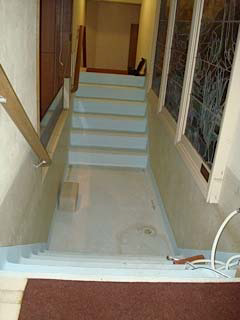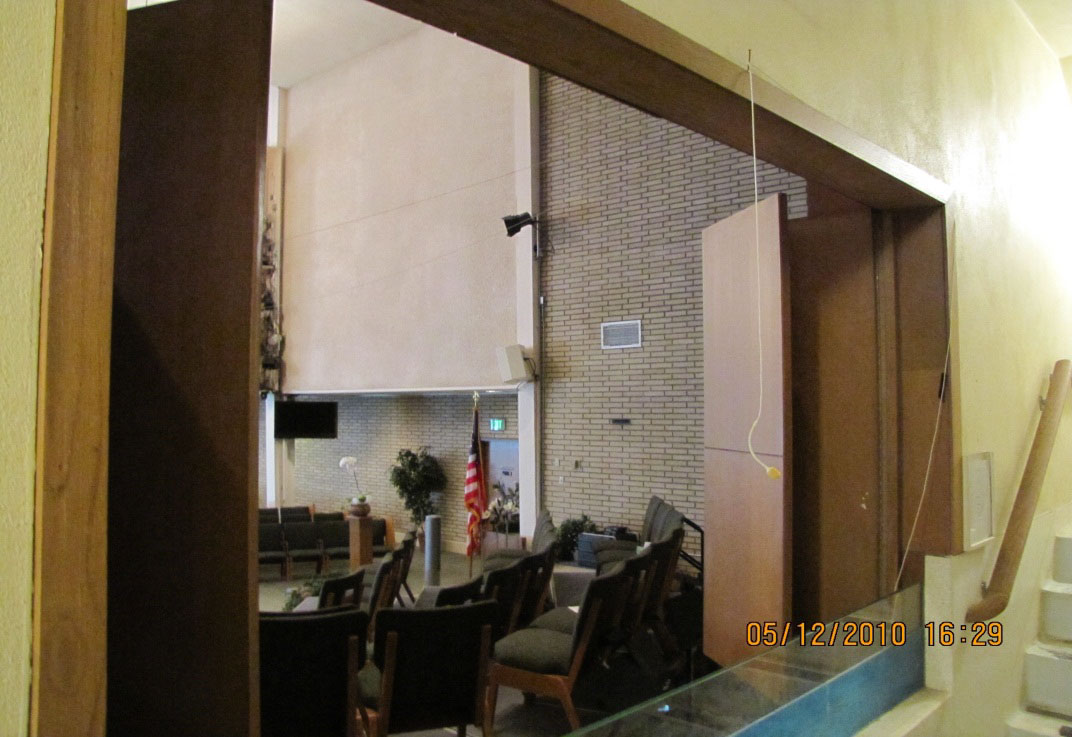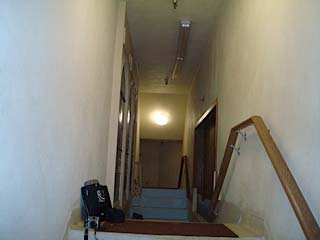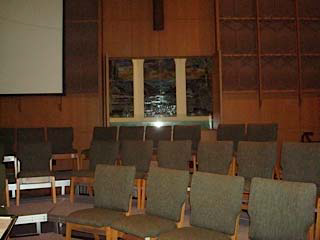Case Report: 12CA002
Maintenance worker dies from exposure to dichloromethane (methylene chloride) while stripping the floor of a baptismal font in a church
Download a PDF to print this report:
Maintenance worker dies from exposure to dichloromethane (methylene chloride) while stripping the floor of a baptismal font in a church (12CA002, PDF)
Summary
A maintenance worker died while using a paint stripper, which contained dichloromethane (methylene chloride), to strip the floor of a baptismal font within a church. The maintenance worker (victim) poured an unknown amount of the paint stripper (up to one gallon) over the steps and floor of the baptismal font and spread it around using a push broom. With the windows and doors open, he then left the area to allow the stripper to work into the surface. He was found later that evening lying face down on the baptismal font floor with the doors and windows closed. The victim was wearing an unknown type of glove and was not wearing any other personal protective equipment. There was no local or general exhaust ventilation in place to prevent harmful exposure. Contributing factors identified in this investigation were the use of a paint stripper containing methylene chloride, an enclosed workspace with poor ventilation, and incomplete implementation of a hazard communication program.
The CA/FACE investigator determined that in order to prevent exposure to methylene chloride, employers should ensure that:
- A hazard analysis is performed to determine the risk of exposure to toxic levels of methylene chloride.
Introduction
On Tuesday, May 11, 2010, at approximately 9:30 p.m., a 24-year-old Hispanic maintenance worker was stripping the paint off the floor and steps within a baptismal font when he died from exposure to methylene chloride. The CA/FACE investigator received notification of this incident on May 13, 2010, from the Monrovia District Office of the Division of Occupational Safety and Health (Cal/OSHA). On March 19, 2012, the CA/FACE investigator interviewed the pastor of the church, reviewed safety documents, and inspected and took pictures of the incident scene. Copies of the police and coroner reports were also obtained. On March 21, 2012, the Cal/OSHA file on this incident was reviewed.
Employer
The employer of the victim was a Baptist church that was established in 1887. Over the past 125 years, the church has grown to its present capacity of serving the spiritual needs of over 1200 parishioners. The church employs 28 people in different capacities from ministry to maintenance.
Written Safety Programs and Training
The church currently has a written safety program and an Injury and Illness Prevention Program (IIPP) but this did not exist at the time of the incident. The church trained and tested their maintenance workers with written and video-based materials for the work they would be asked to complete. The victim was given instructions on how to strip the stairs and floor of the baptismal font by the assistant pastor. The victim used his own gloves and was not issued any other personal protective equipment (PPE) by his employer.
Worker Information
The victim was a 24-year-old Hispanic male who was born in the United States. He was recently honorably discharged from the U.S. Army where he had served a tour of duty in Iraq. The victim had been searching for employment for some time when he and his mother attended the services at the church for spiritual guidance. After sharing the maintenance experience he received in the Army with the pastor of the church, he was hired as one of the maintenance workers for the church and worked the second shift from 12:30 p.m. to 9:30 p.m. He had worked in this position for one month before the incident occurred. The victim spoke both English and Spanish and had been attending a local community college.
Product Used in Incident
The product involved in this incident was a liquid paint stripper (Klean-Strip) containing methylene chloride (70-85%), methanol (1-4%), isopropyl alcohol (1-5%), 2-butoxyethanol (1-5%), and ethyl alcohol (1-5%) according to the Material Safety Data Sheet. The product was purchased from a local home improvement store by church staff. The product's empty container was found by the emergency response team in the church trash container. The total volume of the empty container was 3.79 liters; it is not known whether the container was full when the victim began the paint stripping.
Incident Scene
The incident scene was the baptismal font within the main worship area of the church. The baptismal font for this church was a built-in fixture of the church that resembles a large walk-in bathtub. The baptismal font was located within a narrow room (41' long x 4' wide x 12' high) with doors at each end and a large window facing the congregation to allow the worshipers to witness baptisms (see Exhibit 1). The baptismal font was eight feet long by four feet wide. The font was made out of a common resin that had been painted. The paint coating was peeling and needed to be stripped about every 3 to 5 years.
Investigation
On the day of the incident, the victim was assigned to remove the paint from the stairs and floor of the baptismal font using the paint stripper. According to statements of the assistant pastor, the victim was instructed to be sure the area was well ventilated, to work no longer than 15 minutes at a time with the chemical, and to wear a mask and gloves. However, no mask, gloves, or means of mechanical ventilation were provided to the victim. The victim used his own personal gloves (type unknown) during the task.
In the early afternoon, the victim applied the paint stripper to the floor and steps of the baptismal font. He used a push broom to spread the paint stripper around the surface. At approximately 3:30 pm, the victim spoke with the assistant pastor and told him that the chemical had been applied and was soaking into the paint. The doors and window to the baptismal font room were open at that time and a box fan was in use.
At approximately 9:30 p.m., church volunteer custodians were doing a walkthrough to ensure that the lights were off and the building was secure and locked. When they reached the hall leading to the baptismal font, they noticed light coming from under the door. When they opened the door to investigate, they found the victim lying face down at the bottom of the font. The doors and windows to the baptismal font were closed. They immediately left the area and called 911. The police, fire department, and paramedics arrived and pronounced the victim dead at the scene.
Contributing Factors
Occupational injuries and fatalities are often the result of one or more contributing factors or key events in a larger sequence of events that ultimately result in an injury or fatality. The CA/FACE team identified the following contributing factors in this incident that ultimately led to the fatality:
- Use of a paint stripper that contained methylene chloride.
- An enclosed space with poor ventilation.
- Incomplete implementation of a hazard communication program.
Cause of Death
The cause of death according to the death certificate was acute methylene chloride intoxication.
Recommendation
In order to prevent exposure to methylene chloride, employers should ensure that:
Recommendation #1: A hazard analysis is performed to determine the risk of exposure to toxic levels of methylene chloride.
Discussion: In this incident, the church maintenance worker was overcome by dangerous levels of methylene chloride vapors inside the room with the baptismal font. The victim may have applied the entire can of paint stripper (3.79 liters) to the steps and floor of the baptismal font. Based on the room size and quantity of methylene chloride, a peak concentration of over 30,000 ppm could have occurred in the room. Concentrations of greater than 2,300 ppm of methylene chloride are Immediately Dangerous to Life and Health (IDLH). It is not known why the victim closed the doors and window to the baptismal font room, but he may have wanted to prevent the vapors from entering the congregation area. While the assistant pastor gave general instructions to the victim about how the strip the baptismal font coating, neither probably understood that methylene chloride is a highly volatile chemical that could result in dangerous airborne levels with the doors and window closed. The label on the paint stripper advised that it should be used with ventilation, but this warning did not prevent the victim from using the product without proper precautions.
Prior to beginning tasks that require the use of a paint stripper, the employer should perform a hazard analysis to determine the risk of exposure to toxic levels of vapors, such as methylene chloride. As methylene chloride is highly volatile, use of relatively small quantities in poorly ventilated spaces can lead to lethal levels of solvent vapor. A hazard analysis should include inspecting the following:
- The location of the surface to be stripped. Indoor use of paint strippers is more hazardous than outdoor use.
- The size of the room where the surfaces are located.
- The ventilation in the room. Local exhaust ventilation and fresh air exchange are essential to keep vapors from building up to toxic levels. Mechanical ventilation (not just a ceiling fan) must be used to introduce fresh air and keep methylene chloride in air to levels below regulatory limits and to the lowest levels achievable.
- The respirator. If the work is continuous, only an air-supplied respirator should be used for protection from methylene chloride. Cartridge respirators saturate quickly and dust masks do not provide protection.
- The gloves. Latex or nitrile gloves will not protect against skin absorption of methylene chloride. Only chemically resistant polyvinyl gloves (PVA) can provide adequate protection.
After a hazard assessment is performed, many employers may determine that controlling the risk of exposure to methylene chloride is not feasible or beyond the scope of their usual work activities. In that case, non-methylene chloride based methods should be used to strip paint. These include mechanical, abrasive methods or the use of benzyl alcohol based strippers that work as well (and cost about the same). These benzyl alcohol based strippers are available in local home improvement stores. Some alternative paint strippers contain n-methypyrrolidone (or NMP), but these products are a potential hazard to pregnant women and should be avoided. If methylene chloride must be used to strip paint, employers should contract with professionals who can implement the necessary measures to control hazardous exposures.
If the church employer had recognized the danger of using a methylene chloride-based stripper in the baptismal font room, alternative methods may have been selected or a trained professional could have been hired to perform the work. A trained professional would most likely have assessed the work conditions and decided to select a safer method or product to perform the job, or used appropriate ventilation and/or a supplied air respirator along with personal protective equipment to perform the task safely. In either instance, the victim would not have used a potentially dangerous product and died in the enclosed room.
Exhibits

Exhibit 1. The floor and stairs of the baptismal font.

Exhibit 2. The window within the baptismal font that opens to the church worship area.

Exhibit 3. The narrow hallway leading to the baptismal font.

Exhibit 4. A view of the baptismal font from inside the worship area.
References
California Code of Regulations - Subchapter 7. General Industry Safety Orders
Group 1. Introduction
§3203. Injury and Illness Prevention Program.
Group 16. Control of Hazardous Substances
Article 108. Confined Spaces
§5156. Scope, Application and Definitions. §5157. Permit-Required Confined Spaces.
§5158. Other Confined Space Operations.
Article 109. Hazardous Substances and Processes
§5194. Hazard Communication.
Article 110. Regulated Carcinogens
§5202. Methylene chloride.
NIOSH Workplace Safety and Health Topics (http://www.cdc.gov/niosh/topics/methylenechloride/)
Michigan Case Report: 10MI013 (http://www.cdc.gov/niosh/face/stateface/mi/10MI013.html)
Fatal Exposure to Methylene Chloride Among Bathtub Refinishers — United States, 2000–2011. MMWR February 24, 2012 / 61(07); 119-122. (http://www.cdc.gov/mmwr/preview/mmwrhtml/mm6107a2.htm)
OSHA Safety and Health Topics (http://www.osha.gov/SLTC/methylenechloride/)
Acknowledgement
The CA/FACE team would like to thank and acknowledge the pastor and staff of the church for their assistance and cooperation with this report, the local Police and Fire Departments for their assistance, and the California Department of Industrial Relations Division of Occupational Safety and Health, for their collaboration and assistance with this investigation.
Authors
Hank Cierpich, FACE Investigator
Robert Harrison, MD, MPH, FACE Project Officer
Laura Styles, MPH, Research Scientist
July 19, 2012